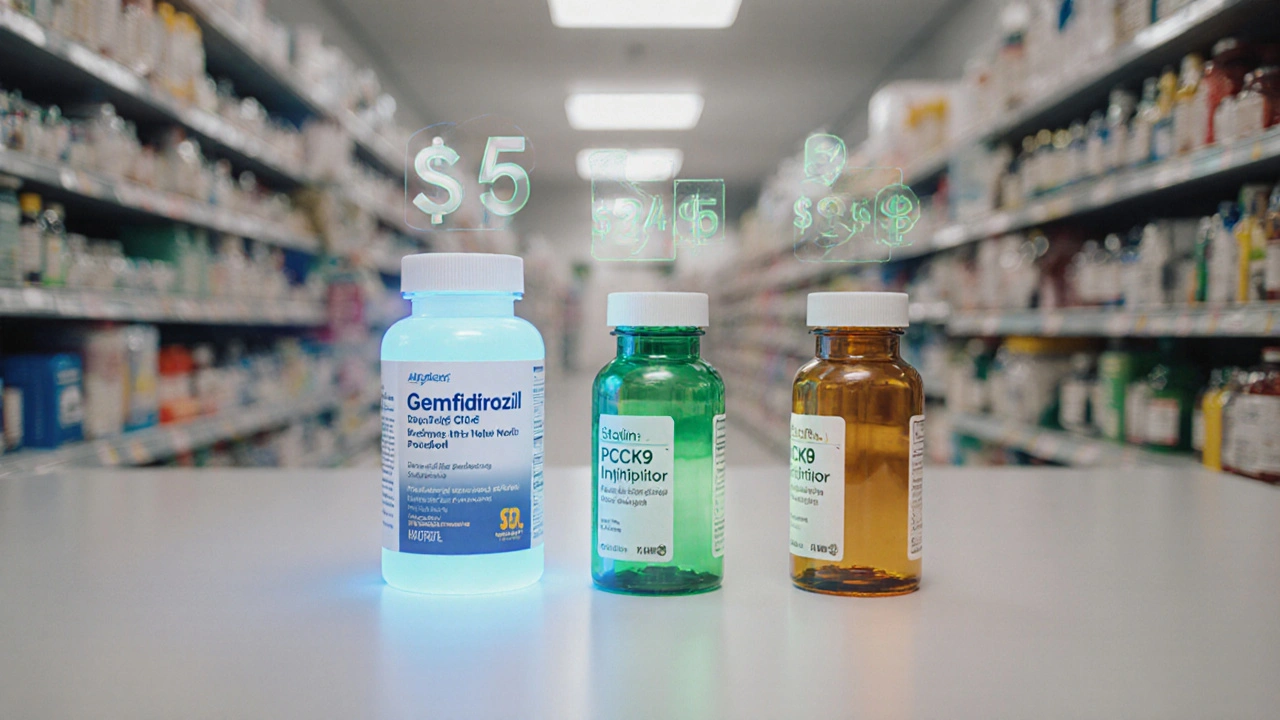Lipid-Lowering Drug Selector
This tool helps determine the most suitable lipid-lowering drug based on your medical profile and current medications.
Enter Your Profile Information
Quick Take
- Lopid (gemfibrozil) mainly lowers triglycerides and raises HDL.
- Fenofibrate offers similar triglyceride control with a better safety profile for many patients.
- Statins are the first‑line choice for LDL reduction; they also modestly lower triglycerides.
- Niacin can raise HDL but often causes flushing and liver issues.
- Omega‑3 fatty acids are safe, work best for very high triglycerides, and have minimal drug interactions.
When your doctor prescribes a lipid‑lowering medication, the decision isn’t just about cholesterol numbers - it’s about how the drug fits your overall health, other medicines you’re taking, and your cost tolerance. Below is a deep dive that compares Lopid with the most common alternatives, so you can see where each one shines and where it falls short.
Lopid is the brand name for gemfibrozil, a fibric acid derivative that primarily lowers triglycerides and raises high‑density lipoprotein (HDL) cholesterol. It works by activating peroxisome proliferator‑activated receptor‑α (PPAR‑α), which speeds up the breakdown of fatty acids in the liver and muscle. Gemfibrozil is approved for patients with severe hypertriglyceridemia (levels > 500mg/dL) and for mixed dyslipidaemia where triglycerides are a major concern.
How Gemfibrozil (Lopid) Works
The PPAR‑α activation triggers several downstream effects:
- Increases the production of lipoprotein lipase, an enzyme that clears triglyceride‑rich VLDL particles.
- Reduces hepatic synthesis of triglycerides.
- Elevates HDL by decreasing its clearance.
Because it does not target the HMG‑CoA reductase pathway, Lopid has little impact on low‑density lipoprotein (LDL) levels. This makes it a complementary drug when statins alone don’t bring triglycerides down enough.
Key Alternatives to Lopid
Below are the main drug families you’ll hear about when discussing triglyceride‑lowering strategies.
Fenofibrate is another fibric acid derivative, classified as a PPAR‑α agonist like gemfibrozil but with a slightly different chemical structure that often translates to fewer drug‑drug interactions.
Statins (e.g., atorvastatin, rosuvastatin) belong to the HMG‑CoA reductase inhibitor class. They are the cornerstone therapy for lowering LDL cholesterol and carry a modest triglyceride‑lowering effect.
Niacin (nicotinic acid) raises HDL and lowers triglycerides by inhibiting hepatic diacylglycerol acyltransferase‑2, but it frequently causes flushing and can affect liver enzymes.
Omega‑3 fatty acids (eicosapentaenoic acid/EPAand docosahexaenoic acid/DHA) lower triglycerides through reduced hepatic VLDL synthesis and have a very clean safety profile.
PCSK9 inhibitors (e.g., alirocumab, evolocumab) are monoclonal antibodies that dramatically lower LDL; they have a modest impact on triglycerides and are usually reserved for high‑risk patients who can’t tolerate statins.
Bile acid sequestrants (e.g., cholestyramine, colesevelam) bind bile acids in the gut, forcing the liver to use cholesterol to make more bile, thereby lowering LDL. They can raise triglycerides, so they’re not first‑choice for hypertriglyceridaemia.
Triglycerides are the main type of fat in the bloodstream; elevated levels increase the risk of pancreatitis and contribute to atherosclerotic plaque formation when combined with small‑dense LDL particles.
Side‑by‑Side Comparison
| Drug | Class | Primary Effect | Typical Dose | Key Side Effects | Cost (relative) |
|---|---|---|---|---|---|
| Lopid (gemfibrozil) | Fibric acid derivative | ↓ Triglycerides, ↑ HDL | 600mg twice daily | GI upset, gallstones, ↑ risk of statin‑related myopathy | Moderate |
| Fenofibrate | Fibric acid derivative | ↓ Triglycerides, modest ↑ HDL | 145mg daily (micronized) or 160mg daily (extended‑release) | Elevated liver enzymes, renal function impact, muscle pain (less severe with statins) | Low‑moderate |
| Statins (atorvastatin) | HMG‑CoA reductase inhibitor | ↓ LDL (primary), ↓ triglycerides (secondary) | 10-80mg daily | Myopathy, elevated LFTs, rare rhabdomyolysis | Low |
| Niacin | Vitamin B3 derivative | ↑ HDL, ↓ triglycerides | 500-2000mg daily (extended‑release) | Flushing, hyperuricemia, hepatotoxicity | Low |
| Omega‑3 (EPA/DHA) | Polyunsaturated fatty acids | ↓ Triglycerides (strong), anti‑inflammatory | 2-4g daily | Fishy aftertaste, mild GI upset, rare bleeding risk at high doses | Moderate‑high |
| PCSK9 inhibitors (alirocumab) | Monoclonal antibody | ↓ LDL > 60%, modest ↓ triglycerides | 75-150mg subcutaneous every 2weeks | Injection site reactions, nasopharyngitis | High |
| Bile acid sequestrants (cholestyramine) | Resin polymer | ↓ LDL, ↑ triglycerides | 4g 1-4 times daily | Constipation, abdominal bloating, interferes with absorption of other drugs | Low |

Pros and Cons of Lopid
Advantages
- Very effective at dropping triglycerides >50% in many patients.
- Can raise HDL by 10‑20% - useful when HDL is low.
- Oral tablet, taken twice a day, no injection.
Drawbacks
- Significant drug‑drug interaction risk, especially with statins, increasing myopathy risk.
- May precipitate gallstone formation in susceptible individuals.
- Requires fasting lipid panel before initiation; monitoring of liver enzymes and renal function is mandatory.
When to Choose an Alternative
If any of these situations match your profile, an alternative may be smarter:
- Concurrent statin therapy: Fenofibrate is generally safer and can be co‑prescribed with moderate‑ intensity statins.
- Severe renal impairment: Dose‑adjusted fenofibrate or omega‑3s are preferred; Lopid is contraindicated when creatinine clearance <30mL/min.
- History of gallbladder disease: Avoid Lopid; consider omega‑3s or low‑dose niacin.
- Cost sensitivity: Generic statins and fenofibrate are cheaper than brand‑name Lopid.
- Need for LDL‑centric therapy: Statins, possibly combined with a PCSK9 inhibitor, are the go‑to class.
Practical Decision Framework
Use the following simple flow to narrow down the right drug:
- Is LDL the main problem? Yes → Statin (add ezetimibe if needed).
- Is triglyceride >500mg/dL or pancreatitis risk present? Yes → Consider Lopid or Fenofibrate.
- Are you already on a moderate‑ or high‑intensity statin? Yes → Prefer Fenofibrate to avoid myopathy.
- Do you have kidney or liver issues? Yes → Omega‑3s or low‑dose niacin, avoid Lopid.
- Is cost a barrier? Yes → Generic statin + fenofibrate, or OTC omega‑3.
Monitoring & Follow‑Up
Whichever drug you pick, keep these checkpoints in mind:
- Baseline labs: Fasting lipid panel, liver function tests (ALT/AST), creatinine.
- 4‑week check: Repeat lipids to gauge response; adjust dose if triglycerides haven’t dropped at least 20%.
- Every 3‑6 months: Monitor liver enzymes and renal function for fibric acids; check CK if on statin‑fibric combo.
- Adverse symptoms: Report muscle pain, dark urine, severe abdominal pain (possible gallstones) immediately.
Bottom Line
Lopid remains a solid option for patients whose primary battle is extremely high triglycerides and who aren’t on high‑dose statins. However, fenofibrate often provides the same benefit with fewer interaction warnings, and omega‑3 fatty acids give a safe, over‑the‑counter route for modest triglyceride reductions. Match the drug to your lab profile, co‑medications, and budget, and you’ll end up with a plan that tackles both heart‑disease risk and side‑effect concerns.

Frequently Asked Questions
Can I take Lopid together with a statin?
You can, but the combination raises the risk of muscle toxicity. If you need both triglyceride and LDL control, most clinicians prefer fenofibrate with a moderate‑intensity statin because the interaction is milder.
Why would a doctor choose fenofibrate over Lopid?
Fenofibrate has a lower chance of causing gallstones and interacts less with statins. It also has a more convenient once‑daily dosing, which improves adherence.
Are omega‑3 supplements as effective as prescription drugs?
High‑dose EPA/DHA (2-4g) can lower triglycerides by 20‑50% and are very safe. They don’t raise HDL as much as fibric acids, and they lack the LDL‑lowering power of statins, so they’re best used when triglycerides are the main issue.
What side effects should I watch for on Lopid?
Common complaints are stomach upset and mild muscle aches. More serious signs include dark urine (possible rhabdomyolysis), persistent abdominal pain (gallstones), or a sudden rise in liver enzymes. If any appear, contact your doctor right away.
Is Lopid covered by Australian Medicare?
Medicare typically subsidises generic gemfibrozil when prescribed for severe hypertriglyceridaemia, but coverage varies by state and the specific pharmacy’s pricing agreements. Check with your prescriber’s office or local pharmacy for the exact out‑of‑pocket cost.


Andrew Stevenson
September 28, 2025 AT 15:39Great overview! The pharmacodynamics of gemfibrozil, particularly its PPAR‑α agonism, lead to up‑regulation of lipoprotein lipase and enhanced catabolism of VLDL particles. By reducing hepatic triglyceride synthesis, it also indirectly mitigates the formation of small dense LDL, which is atherogenic. The rise in HDL is mediated via decreased hepatic lipase activity, something many clinicians overlook when choosing adjunct therapy. In patients with severe hypertriglyceridaemia (>500 mg/dL), the magnitude of triglyceride reduction often exceeds 50 %, which is clinically meaningful for pancreatitis risk mitigation. However, the drug‑drug interaction profile, especially with statins, necessitates vigilant CK monitoring.
Poorni Joth
October 2, 2025 AT 07:39i cant bElieve how much you forget about the statin risk. its like you dont even read the label!
Yareli Gonzalez
October 5, 2025 AT 23:39Nice summary. If you’re thinking about starting gemfibrozil, remember to get baseline liver enzymes and renal function, then re‑check lipids after 4‑6 weeks to see if you’ve hit that 20 % drop threshold.
Josh SEBRING
October 9, 2025 AT 15:39Honestly, fenofibrate’s safety margin makes it a better first‑line choice for most patients. Gemfibrozil’s propensity to precipitate gallstones and amplify statin‑induced myopathy isn’t worth the marginal extra triglyceride drop.
Taryn Bader
October 13, 2025 AT 07:39This article is a total waste of time.
Myra Aguirre
October 16, 2025 AT 23:39Looks solid. The side‑effect table is especially helpful for quick reference.
Shawn Towner
October 20, 2025 AT 15:39While your endorsement of fenofibrate is noted, the nuanced pharmacokinetic interactions of gemfibrozil with CYP2C8 substrates still warrant consideration in polypharmacy contexts.
Ujjwal prakash
October 24, 2025 AT 07:39Wow!!! This comparison really digs deep-into mechanisms, cost, and even patient adherence!!! The table format is crystal‑clear; however, I would suggest adding a column for “average time to effect”!!!
Diane Helene Lalande
October 27, 2025 AT 22:39Good observation, Ujjwal. Consider using “time‑to‑effect” with a hyphen for clarity.
Edwin Levita
October 31, 2025 AT 14:39Honestly, reading this felt like watching paint dry-so boring!
Melissa Gerard
November 4, 2025 AT 06:39Meh, could have been shorter. 😒
beverly judge
November 7, 2025 AT 22:39Melissa, brevity is valuable, but remember to keep the essential safety points; otherwise readers might miss critical warnings.
Capt Jack Sparrow
November 11, 2025 AT 14:39The comprehensive nature of this article provides clinicians with an invaluable decision‑making framework. By systematically addressing triglyceride thresholds, concurrent statin use, and organ function, the tool aligns with guideline‑driven personalized medicine. Moreover, the inclusion of cost considerations acknowledges real‑world prescribing constraints that many publications overlook. The mechanistic explanations of PPAR‑α activation are sufficiently detailed to satisfy pharmacology‑savvy readers while remaining accessible to general practitioners. The side‑effect profiles are presented succinctly, allowing quick cross‑reference during patient consultations. Additionally, the monitoring schedule-baseline labs, 4‑week lipid reassessment, and quarterly safety checks-mirrors best‑practice recommendations. The emphasis on patient education, particularly regarding muscle pain and gallstone symptoms, reinforces a proactive safety culture. While the comparison favors fenofibrate for its interaction profile, it does not dismiss gemfibrozil’s superior efficacy in extreme hypertriglyceridaemia, preserving therapeutic nuance. The table’s visual clarity aids rapid comparison across drug classes, which is especially helpful in busy clinic settings. The article also briefly touches on emerging therapies like PCSK9 inhibitors, indicating awareness of evolving treatment landscapes. By acknowledging the limitations of bile‑acid sequestrants in triglyceride‑rich patients, the piece avoids over‑generalization. The discussion of omega‑3 fatty acids’ safety profile provides a realistic alternative for patients intolerant to fibric acids. Overall, the integration of clinical, pharmacologic, and economic data creates a holistic guide. Readers are left with actionable steps: assess labs, consider comorbidities, choose the appropriate agent, and schedule follow‑up. This structured approach is likely to improve patient outcomes and reduce adverse events.
michael abrefa busia
November 15, 2025 AT 06:39Super helpful guide! 👍💊
Bansari Patel
November 18, 2025 AT 22:39If we view lipid management as a dialogue between biology and economics, then privileging low‑cost generic gemfibrozil over newer agents reflects a societal commitment to equity in health.
Rebecca Fuentes
November 22, 2025 AT 14:39The article adheres to a logical structure, beginning with patient assessment and culminating in therapeutic recommendations, thereby facilitating its use as a clinical reference.
Jacqueline D Greenberg
November 26, 2025 AT 06:39Totally get it-choosing the right med can feel overwhelming, but this breakdown makes it way less scary.
Jim MacMillan
November 29, 2025 AT 22:39While the structure is commendable, a deeper dive into comparative meta‑analyses would elevate the discourse beyond mere summarization.
Dorothy Anne
December 3, 2025 AT 14:39Great job covering all the bases; now we just need more real‑world case studies to see how these recommendations play out in practice.